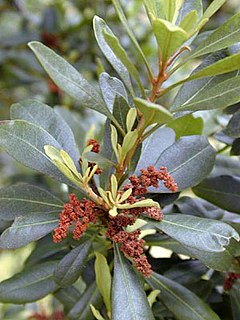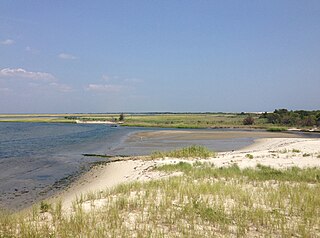
Waxes are a diverse class of organic compounds that are lipophilic, malleable solids near ambient temperatures. They include higher alkanes and lipids, typically with melting points above about 40 °C (104 °F), melting to give low viscosity liquids. Waxes are insoluble in water but soluble in organic, nonpolar solvents. Natural waxes of different types are produced by plants and animals and occur in petroleum.

Myrica is a genus of about 35–50 species of small trees and shrubs in the family Myricaceae, order Fagales. The genus has a wide distribution, including Africa, Asia, Europe, North America and South America, and missing only from Australia. Some botanists split the genus into two genera on the basis of the catkin and fruit structure, restricting Myrica to a few species, and treating the others in Morella.

The Myricaceae are a small family of dicotyledonous shrubs and small trees in the order Fagales. There are three genera in the family, although some botanists separate many species from Myrica into a fourth genus Morella. About 55 species are usually accepted in Myrica, one in Canacomyrica, and one in Comptonia.

Myrica rubra, also called yangmei, yamamomo, Chinese bayberry, Japanese bayberry, red bayberry, yumberry, waxberry, or Chinese strawberry is a subtropical tree grown for its fruit.

Xerophyllum asphodeloides is a North American species of flowering plants in the Melanthiaceae known by the common names turkey beard, eastern turkeybeard, beartongue, grass-leaved helonias, and mountain asphodel. It is native to the eastern United States, where it occurs in the southern Appalachian Mountains from Virginia to Alabama, and also in the Pine Barrens of New Jersey.

Myrica californica is an evergreen shrub or small tree native to the Pacific Ocean coast of North America from Vancouver Island south to California as far south as the Long Beach area.
Bayberry wax is an aromatic green vegetable wax. It is removed from the surface of the fruit of the bayberry (wax-myrtle) shrub by boiling the fruits in water and skimming the wax from the surface of the water. It is made up primarily of esters of lauric, myristic, and palmitic acid.

Island Beach State Park is a New Jersey state park located just south of Seaside Park on the Barnegat Peninsula in Berkeley Township, Ocean County, New Jersey, United States. The park is operated and maintained by the New Jersey Division of Parks and Forestry. Most of the park encompasses the former borough of Island Beach.

Myrica pensylvanica, the northern bayberry, is a species of Myrica native to eastern North America, from Newfoundland west to Ontario and Ohio, and south to North Carolina. It is also classified as Morella pensylvanica.

Myrica faya is a species of Myrica, native to Macaronesia, and possibly also western coastal mainland Portugal.

Nageia nagi, the Asian bayberry, is plant species in the family Podocarpaceae named by Carl Peter Thunberg. Nageia nagi is native to China, Japan, and Taiwan. It was formerly called Podocarpus nagi.

Myrica cerifera is a small evergreen tree or large shrub native to North and Central America and the Caribbean. Its common names include southern wax myrtle, southern bayberry, candleberry, bayberry tree, and tallow shrub. It sees uses both in the garden and for candlemaking, as well as a medicinal plant.
Dendrosenecio johnstonii, formerly Senecio johnstonii, is a giant groundsel found in the middle altitudes of Mount Kilimanjaro in Africa. A recent botanical reclassification split off some species formerly in Senecio, putting the giant groundsels in the new genus Dendrosenecio. It also redefined the former species Senecio cottonii, as a subspecies of Dendrosenecio johnstonii. Both genera are in the family Asteraceae. The giant grounsels of the genus Dendrosenecio evolved, about a million years ago, from a Senecio that established itself on Mount Kilimanjaro, with those that survived adapting into Dendrosenecio kilimanjari. As it moved down the mountain, the adaptations necessary for the new environment created the new species, Dendrosenecio johnstonii. Various subspecies are found on other mountains.

Myrica hartwegii, known by the common names Sierra sweet bay and Sierra bayberry, is a species of shrub in the bayberry family.
G. californica may refer to:
Strepsicrates smithiana, the bayberry leaftier moth or Smith's strepsicrates moth, is a moth of the family Tortricidae. It was first described by Lord Walsingham in 1891. It is native to southern North America, south to South America, including Florida, Texas, Georgia, Dominican Republic, Puerto Rico, Cuba and the Galapagos Islands. It was introduced to Oahu, Hawaii, in 1955 to aid in the control of Myrica faya.

Myrica esculenta is a tree or large shrub native to the hills of northern India, southern Bhutan and Nepal. Its common names include box myrtle, bayberry and kaphal. Its berries are edible and are consumed locally.
The East Gulf coastal plain savanna and wet prairie is a herbaceous wetland community found in the eastern Gulf coastal plain, in the states of Mississippi, Alabama, and Georgia. It is also known as a "lush grassland", "grass-sedge savannah", or "wet savanna".

Myrica caroliniensis is a shrub or small tree native to the coast and coastal plains of southeastern North America. Its common names include bayberry, southern bayberry, pocosin bayberry, and evergreen bayberry. It sees uses in the garden and for candlemaking, as well as a medicinal plant.














